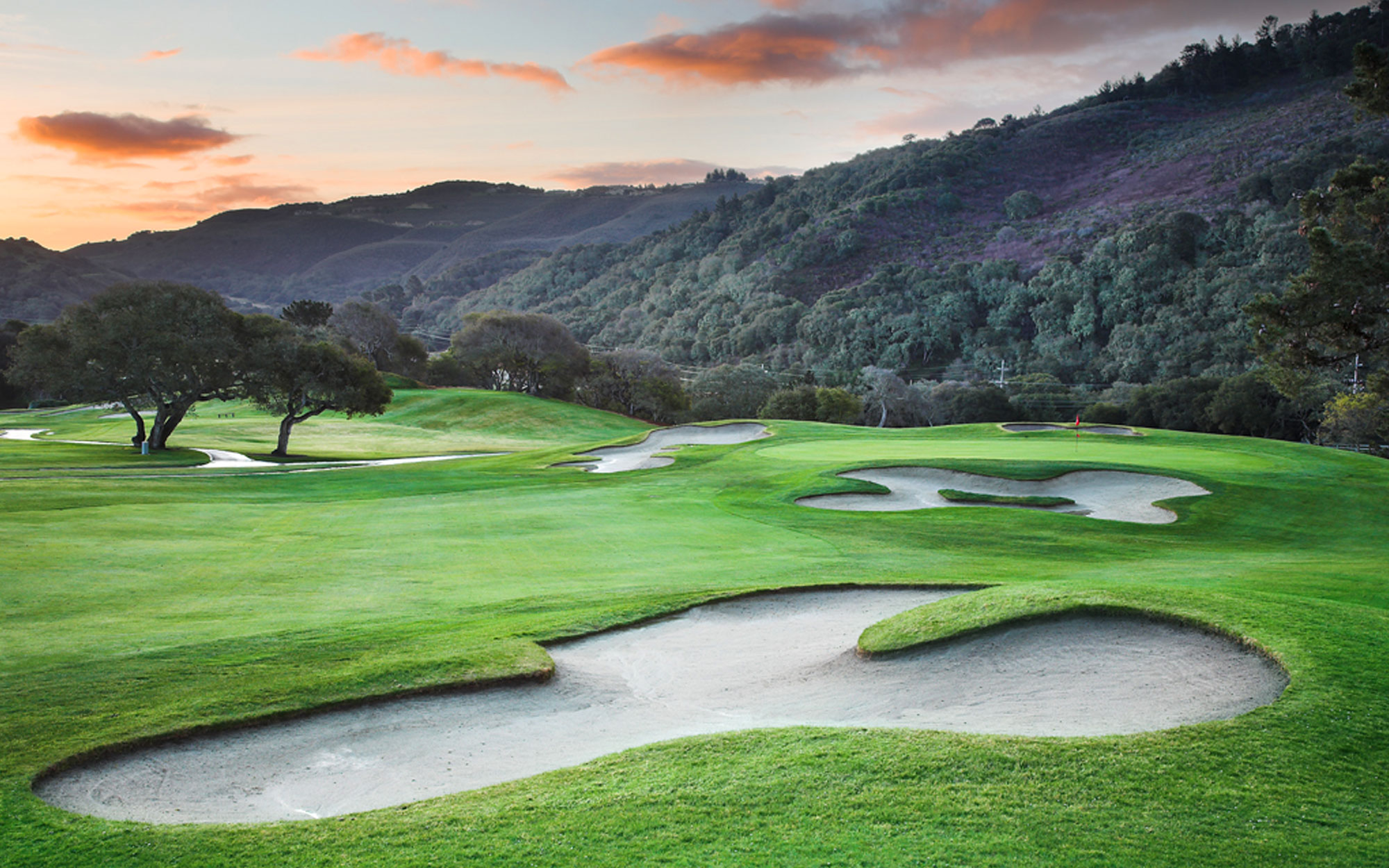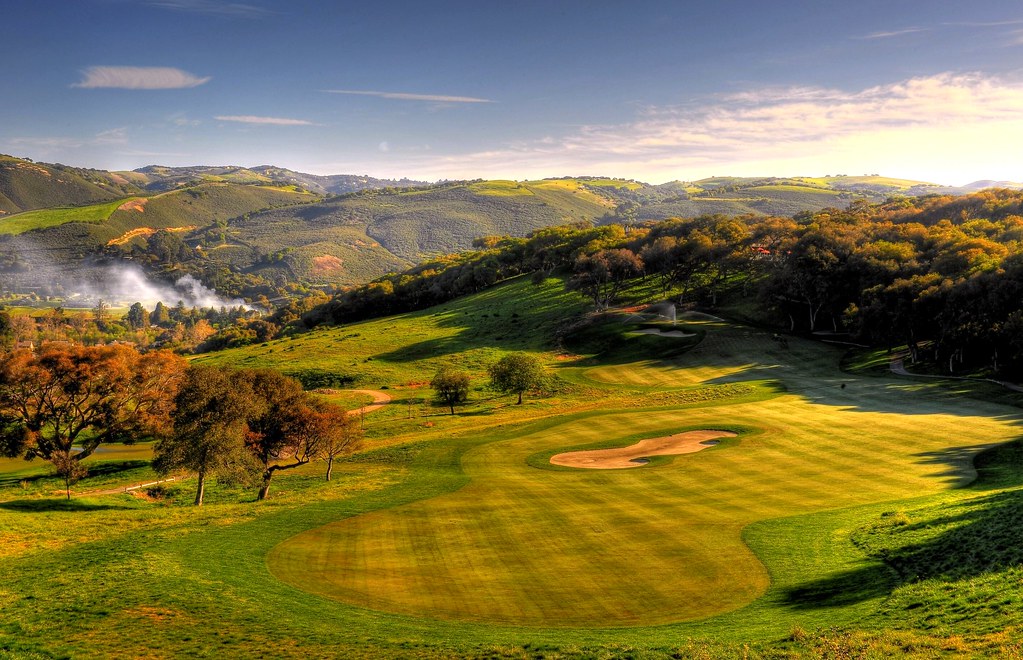
Laguna Seca
Every discussion about playing golf on California’s verdant and the uber-enticing Monterey Peninsula begins with the courses at the Pebble Beach Resort, but the talk doesn’t have to stop there.
The region — set about two hours south of San Francisco — has 18 public golf courses that are not affiliated with the famous resort, many of them noteworthy for their history as much as their routings, their playability and the gorgeous setting, with courses both on the coast and a few miles inland in the plateaus formed by the rolling hills.
We have detailed below three of our favorites in the area, courses that won’t dent your wallet as much as some at the famed resort while still providing plenty of challenges and memorable experiences.
These are snapshots of courses designed by the likes of Pete Dye, Todd Eckenrode, and the father and son team of Robert Trent Jones Sr. and Jr. — courses that helped make this region a golf hotbed and a must-play destination on your bucket list, even without a tee time at Pebble.
Golf course at Carmel Valley Ranch has split personality
Nestled in the foothills of the Santa Lucia Mountains about 10 miles inland from the town of Carmel, the 400-acre Carmel Valley Ranch is a golfer’s paradise. Its Dye-designed course, the only one fashioned by the late, great golf course architect in Northern California, winds through the core of the expansive resort from the valley floor down the foothills and up to significant elevation.
The 18-hole, par-70 track has earned a reputation for its stunning views and a combination tactical challenges and playability, with a handful of the designer’s creative features but on a smaller scale than some of his courses are known for.
At Carmel Valley Ranch, instead of Monterey pine, you get blue and madrone oaks. Instead of bluffs along the ocean, you get the mountain green wooded foothills. Carmel Valley Ranch has only two par 5s. Its par 3 holes range from a short 110 yards to 200-plus.
The course has the golf equivalent of a split personality. The first four holes seem like a typical parkland layout, and for most part, the front nine is flat as positioned along the beautiful Carmel River and features very tight fairways and tricky putting surfaces. The corridors are narrowed by thoughtfully conceived water hazards and strategically placed bunkers, many at the turns of the doglegs.
The character and terrain change on the back nine, which is situated 350 feet above the valley floor among the knolls of the national forest, offering some of the most breathtaking elevated tee shots in all of Monterey.
The par-5 10th is barely more than 450 yards and climbs in excess of 60 feet. The view on No. 11’s tee is stunning, with the tee shot dropping more than 150 feet to the fairway. The tee shot on the par-4 12th is blind, and though the par-3 13th is a short iron downhill to the green, from the back tees much of the putting surface cannot be seen.
It’s a course that starts rather benign at first but then turns into a challenging test in a lovely, natural setting. Destinations Magazine has ranked the golf course at Carmel Valley Ranch as one of the 25 most challenging courses in California.

Carmel Valley Ranch
Laguna Seca Golf Ranch is a wonderful pairing of Jones, Jones Jr.
Designed by RTJ and RTJ II and opened in 1970, Laguna Seca Golf Course is carved through the oak-studded hills of Monterey County between Monterey and Salinas. The course presents narrow uneven fairways, a smattering of strategically placed bunkers and uphill and downhill doglegs.
Don’t let this par-71, 6,226-yard golf course fool you, as yard-for-yard, it is one of the most exacting layouts in the area. Uphill holes require more club on your approach shots and there are many holes, such as the 15th, where water comes into play more than once.
Laguna Seca Golf Ranch turns on the difficulty at the par-5 third, which is fairly tight, increasing the demand for precision. Tricky doglegs highlight the sixth and the seventh holes and force game management. The ninth, an uphill, 404-yard par-4, plays more like 500 yards, especially against the wind.
Big hitters can drive the 11th, a particularly fun, 332-yard, downhill dogleg right, if they take it over the trees.
Laguna Seca Golf Ranch’s signature hole and the most difficult on the golf course, is the aforementioned par-5 15th. Lay up short of the big, deep bunker as there is a lake just beyond that requires a carry to a fairway. It can prove difficult to get over the hazard from the bunker, especially if the hole plays into the prevailing wind. And even if you clear the first lake, another water hazard looms in front of the green.
The goal on the par-3 17th hole is selecting the proper club to avoid five bunkers and find the putting surface.
Laguna Seca Golf Ranch’s hilly topography and variety of holes force the golfer to use creativity on their approaches. Most of the Poa annua greens are big and receptive although a few are deceptive when considering the line.
On a historic note, the club sits on land that was once part of a 2,197-acre Spanish land grant deeded in 1834 to Catalina Manzanelli de Munras.

Laguna Seca
Quail Lodge & Golf Club is sublimely fun
The golf experience at Quail Lodge & Golf Club has always been wonderful, thanks to a sublime setting seven miles inland from Pebble Beach Resorts and the Pacific Ocean on the 850-acre ranch that has the feel of “old California.”
The course here was originally designed by Robert Muir Graves, who routed his track through an exclusive neighborhood in the secluded Carmel Valley. In 2014 and 2015, Eckenrode and his Origins Golf team revitalized the course, modernizing Quail Lodge’s tee boxes, bunkers and fairway features while making improvements to the chipping areas.
Drought-tolerant landscaping was also introduced with the aim of encouraging resource efficiency.
Stronger players are challenged by the course at Quail Valley, and on many holes there’s an option of bouncing the ball into the greens, elevating the level of interest to approach shots — some will kick onto the green, or run farther away, depending on the slopes. The course has been refined to allow for players to utilize the contours of the land.
Quail Lodge is 6,464 yards and is a relatively flat course. The bunkers lining many fairways and surrounding many greens can be penal, and a mix of doglegs that are accented with large, bushy trees make the course very interesting.
Deep grass swales must be navigated on the first three holes, specifically on the left side of the landing area off the tee and crossing the fairway in front of the second shot on the first hole, then traversing across the second hole before meandering up through the third hole.
Eckenrode’s changes have produced what’s likely to become Quail Lodge’s best par-5, the 542-yard first hole on which a lone fairway bunker off the tee is easily carried for most players. The hole has substantial room left if necessary, with the green tucked up against a cliff, providing a dramatic look all the way down the left side of the hole.
Overlooking holes Nos. 15-18 from the cliff above is actress Dinah Shore’s former estate. On the par-3 17th, the old pond was replaced by Eckenrode with a green-side bailout area that offers several options to play a shot that misses the green left.
Nowhere in Northern California are there purer Poa annua greens than at Quail Lodge. There is only one forced carry off the tee, making it more playable for the casual and resort golfer.
Among the best public courses on the Monterey Peninsula, the fun of shaping shots applies throughout at Quail Lodge. It’s a blast to tackle and play on repeat if you have the time.

Quail Lodge

